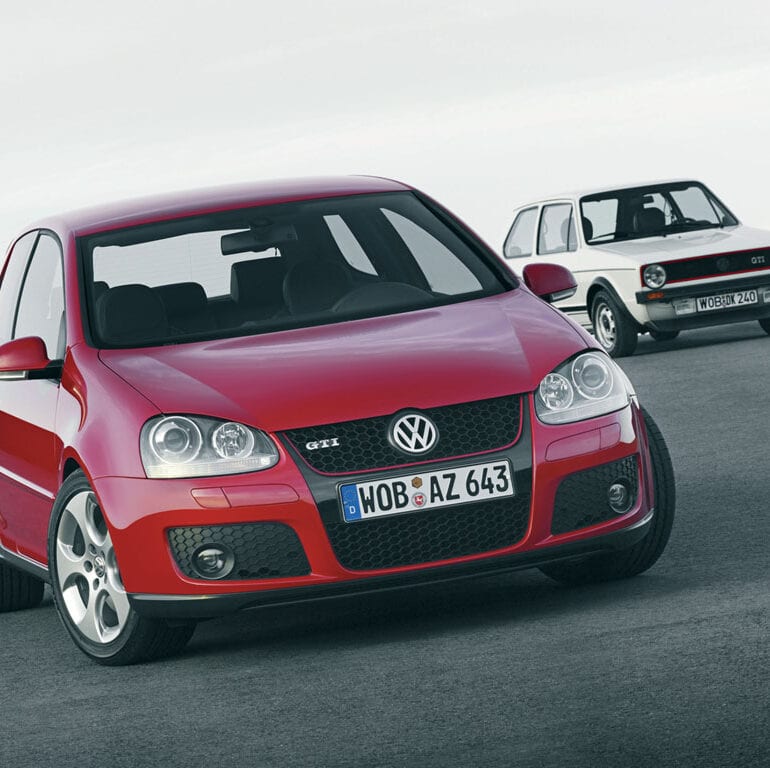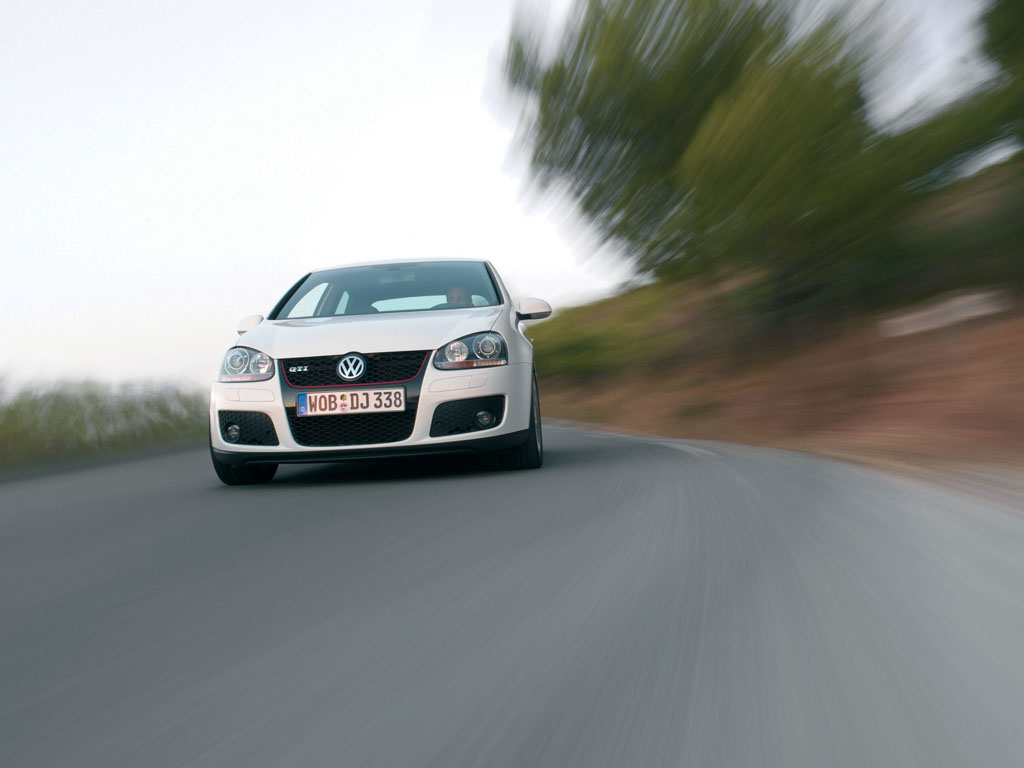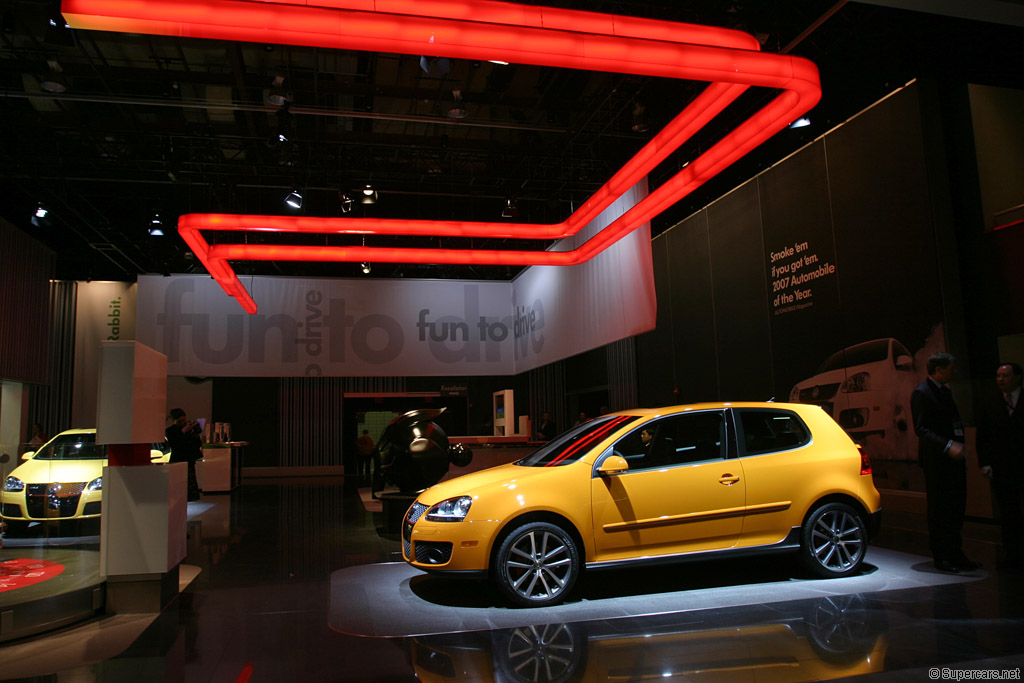Wolfsburg / Paris, 23. September 2004. The Golf GTI is a cult object. Number produced: more than 1.5 million. 93.2 percent of all Europeans recognise it. To them, Grand Tourisme Injection means driving pleasure and great handling. And now the new Golf GTI is here: Its launch phase is being started at the Paris Motor Show.
The new model was shown for the first time as a study at the IAA in Frankfurt. Volkswagen is keeping its word and – as announced precisely one year ago – is launching the fifth Golf GTI generation on the first European markets in the autumn. It is thus closing the circle by linking back up to the original version in the series. Faster, more powerful and more independent than ever this Golf is, in the pure sporting tradition, honest and striking.
GTI engine / the 2.0 T-FSI
Available in both a two-door and four-door version, the Golf GTI is powered by the 2.0 T-FSI. It has a high compression ratio of 10.5:1 and stands out because of its powerful torque from 1,800 and 5,000 rpm which makes it the ideal sports car engine. Also, for the first time, Volkswagen is using a direct injection petrol engine with exhaust turbo charger.
In design terms, the new engine harks back to the 2.0 FSI Series EA-113 with coated direct petrol injection, as already used in the Golf. The main objectives in the development of the turbocharged FSI were, in terms of typical GTI characteristics, a clear improvement in performance whilst retaining the existing low consumption and emission values. Thanks to the core technologies of direction injection, turbocharging, continuous intake camshaft adjustment, variable controlled intake manifold and further modifications inside the engine, a very high level of efficiency was achieved. Like all Golf engines, the 2.0 T-FSI meets the requirements of the EU4 standard.
GTI exterior
The new Golf GTI is clearly a GTI from almost every angle. This applies for the front section in particular: For the first time in almost 30 years of the GTI, it is completely different from the other Golf models in terms of its totally independent radiator grill design. And so, more than ever, this front section, with a black radiator grill with a red frame strip, succinctly expresses the GTI look.
The grid of the radiator grill is made up of a honeycomb structure. The same is true of the recesses for the fog lamps which are located to the left and right of the lower radiator grill element and designed in the style of additional air inlets. With this completely new, powerful design, the integrated front spoiler below and the 15 mm lower sports running gear, the Golf GTI appears to suck up the road and the air in front of it. Other visual GTI features: the darkened headlight frame (or in light chrome with Xenon) and, or course, the GTI lettering incorporated into the grid.
In the tail sector, it is the striking roof edge spoilers, the polished stainless steel double exhaust pipe ends (diameter: 2 x 70 mm) and the newly designed lower bumper that characterise this Golf as a sports car. The tail spoiler provides a clear aerodynamic function by increasing the contact pressure of the Golf GTI, which can reach 235 km/h, on the road.
GTI equipment and design elements also dominate the vehicle’s outline: Here, it is the 17 alloy wheels (type: Denver) fitted as standard, with the 225/45 tyres, the lowering of the running gear described above, the red painted brake callipers of the particularly stable 16 brake system, combined as standard with ESP, discreet black sill extensions and a black high-gloss baffle at the B pillars that give the GTI its extra flair.
The colours used for the exterior of the GTI also reflect its sporty appeal. There are colours, after all, which go more with the interplay of the black and red GTI specifications. Tornado Red and Plain Black for example, or Candy White, a shade similar to that offered for the original GTI. In addition, the Golf GTI is available in Pearl Blue, Black Magic Pearl Effect, Reflex Silver Metallic, Blue Graphite Pearl Effect, United Grey Metallic, Shadow Blue Metallic and Laser Blue Pearl Effect.
GTI interior
The interior of the new Golf GTI shows the same kind of unique attitude as a classic interior, with the technologies and stylistic devices of the 21st century.
The newly designed GTI seats provide comfort with excellent side bolsters and sporting appeal. There breathable ‘Interlagos’ seat covers, whose classic design harks back to the look of the first generation of GTI seats, have also been newly developed. Anthracite and Pure Beige leather seats are also available as an option. The GTI lettering is integrated into the adjustable headrests.
Like the first Golf GTI, the new generation also features a three-spoke steering wheel with aluminium inlays. Today, however, they are covered with perforated leather as standard, which gives an excellent grip. aluminium is also featured on the GTI gear stick, the decorative inserts (brushed aluminium) and the pedals. Another typical GTI feature is the black roof lining. Even the instruments have been designed specially for the GTI: The rev counter goes up to 8,000 rpm and the speedometer has been extended to the higher ranges. The instruments are enclosed in a new aluminium frame.
The range of equipment of the GTI also includes as standard – in addition to all the features in the Trendline package – a multifunction display (on-board computer), front foot well lighting, automatic dimming interior mirror with light and rain sensor, the Coming-Home/Leaving-Home light function, which can be controlled from inside, and a tyre pressure monitoring display. Like the entire range, the GTI is also fitted with a complete safety package, including ESP (Electronic Stabilisation Program), crash-active front headrests, three headrests in the back and six airbags.
GTI History
The first series Golf GTI was launched in June 1976. The plan originally was to produce a limited edition of just 5,000. But things turned out differently. The 81 kW / 110 hp Golf GTI with a top speed of 182 km/h conquered a new clientele and formed the basis for the GTI class. 5,000 GTIs turned into more than 1.5 million. Here is a list of the main milestones in the life of the Golf GTI up to the premiere of the fifth generation:
1976-The first generation Golf GTI with 81 kW makes its debut 1979-Facelift 1982-Introduction of the special Pirelli-GTI model 1982-Golf GTI now produces 82 kW 1984-Debut of the second generation Golf GTI 1984-Introduction of the catalytic converter (78 kW instead of 82 kW) 1985-Facelift, double headlights and double exhaust pipe ends 1986-Début Golf GTI 16V (102 kW without cat., 95 kW with cat.) 1990-Launch of Golf GTI with G60 engine (118 kW) 1991-Début of third generation Golf GTI with 85 kW 1996-Presentation of the anniversary model: 20 years of GTI 1996-Introduction of Golf GTI with 110 kW (turbo engine) 1996-Launch of the Golf GTI TDI with 81 kW 1998-Debut of fourth generation Golf GTI with 110 kW petrol engine (1.8 T) 2000-Launch of Golf GTI TDI with 110 kW 2001-Launch of Golf GTI with 132 kW turbo 2004-Debut of fifth generation Golf with 147 kW Story by Volkswagen AG, edited by Supercars.net Story by Volkswagen AG, edited by Supercars.net
In Detail
| price $ | $ $23 000 USD |
| engine | All Aluminum FSI Inline-4 w/Turbocharger |
| position | Front Transverse |
| aspiration | Turbocharged & Intercooled |
| valvetrain | DOHC, 4 Valves per Cyl |
| fuel feed | Direct Petrol Injection |
| displacement | 1984 cc / 121.1 in³ |
| bore | 82.5 mm / 3.25 in |
| stroke | 92.8 mm / 3.65 in |
| compression | 10.3:1 |
| power | 149.1 kw / 200 bhp @ 5100 rpm |
| specific output | 100.81 bhp per litre |
| bhp/weight | 150.6 bhp per tonne |
| torque | 280 nm / 206.5 ft lbs @ 1500-5000 rpm |
| redline | 8000 |
| front tires | 225/45 R 17 W |
| rear tires | 225/45 R 17 W |
| front brakes | Discs w/EPBD, ABS |
| f brake size | x 312 mm / x 12.3 in |
| rear brakes | Discs w/EPBD, ABS |
| r brake size | x 286 mm / x 11.3 in |
| front wheels | F 43.2 x 19.0 cm / 17.0 x 7.5 in |
| rear wheels | R 43.2 x 19.0 cm / 17 x 7.5 in |
| steering | Electro-Mechanical servotronic steering with speed-dependent Pow |
| f suspension | MacPherson Struts w/Lower Wishbone, Coil-Over Shocks, Anti-Roll Bar |
| r suspension | 4-Link w/Coil-Over Shocks, Anti-Roll Bar |
| curb weight | 1328 kg / 2928 lbs |
| wheelbase | 2578 mm / 101.5 in |
| front track | 1539 mm / 60.6 in |
| rear track | 1528 mm / 60.2 in |
| length | 4216 mm / 166.0 in |
| width | 1759 mm / 69.3 in |
| height | 1466 mm / 57.7 in |
| transmission | 6-Speed Manual or 6-Speed DSC |
| gear ratios | 3.36:1, 2.09:1, 1.47:1, 0.87:1, 0.73:1, :1 |
| top speed | ~225.3 kph / 140 mph |
| 0 – 60 mph | ~6.5 seconds |
| 0 – 100 mph | ~17.0 seconds |
| 0 – 1/4 mile | ~15.0 seconds |
| drag | 0.32 Cd |














